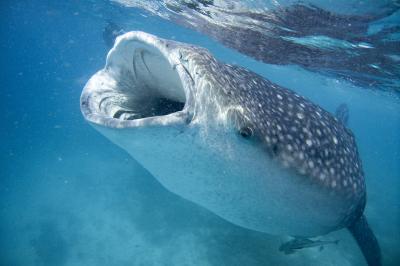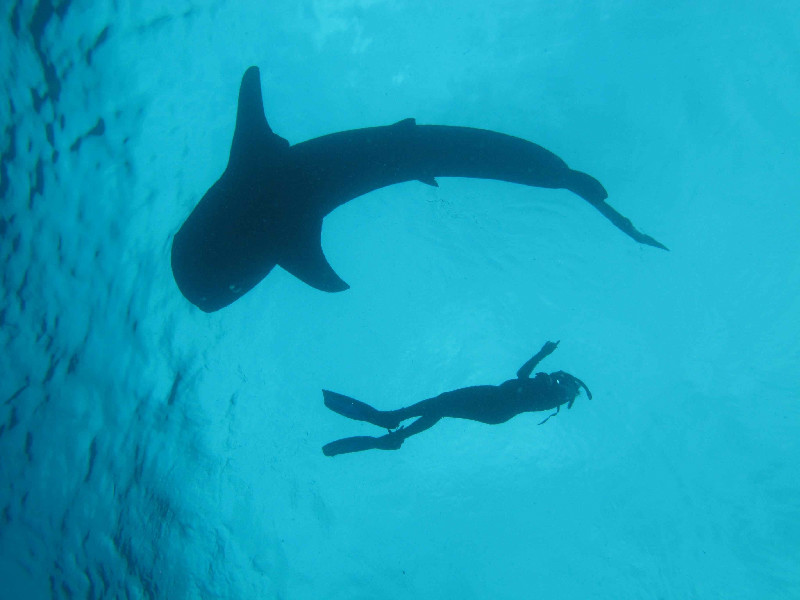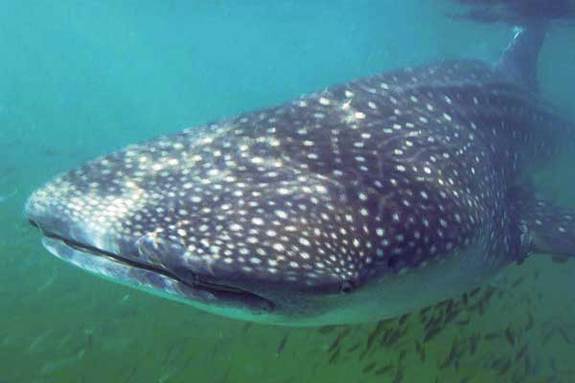Facts About Whale Sharks

Whales sharks are the largest fish in the world. They are not whales; they are sharks. They have a lot in common with whales, though. For example, they are massive like whales and they feed more like whales than a typical shark.
Size & description
Whale sharks can grow up to 40 feet (12 meters) long, but on average they grow to 18 to 32.8 feet (5.5 to 10 m) and weigh 20.6 tons (18.7 metric tonnes). That’s about the size of a school bus.
Great white sharks may get more attention, but they are dwarfed by whale sharks. Great whites are the world's largest predatory fish, according to Discovery. They grow to be about 15 to 20 feet (4.6 to 6.1 meters) or more and can weigh more than 5,000 lbs. (2,268 kilograms). Whale sharks are not predatory.
Whale sharks' heads are flattened and have a blunt snout above its mouth. Short barbels — whiskerlike sensory organs like catfish have — protrude from their nostrils. Their backs and sides are gray to brown with white spots and pale stripes. Their bellies are white. Each whale shark has its own unique pattern of spots, much like human fingerprints.
A whale shark’s mouth is about 5 feet wide (1.5 m). They have rows of over 300 teeth, but as filter feeders they do not use these teeth to eat.
Habitat
Whale sharks tend to like warmer areas and are found in tropical waters all over the world. Some have been spotted in cooler waters, such as those off the coast of New York. Most whale sharks — 75 percent — are found in the Indian and Pacific oceans; 25 percent in the Atlantic, according to the International Union for Conservation of Nature (IUCN).
Habits
Whale sharks are solitary creatures. They don’t shy away from sharing feeding grounds with other whale sharks, though. The Red Sea is a popular area for juvenile whale sharks to hang out together and eat, for example. There isn’t much else known about these types of sharks and their social habits. They haven’t been studied as well as other sea creatures, according to the IUCN.

Diet
These sharks don’t attack and tear apart their prey like most many of their relatives. While they are meat-loving carnivores, whale sharks are filter feeders, according to National Geographic. They open their mouths, let water come in and their bodies filter out food, and release the water and any debris back into the ocean.
Plankton are their main food source, but they also eat shrimp, algae and other marine plant material, sardines, anchovies, mackerels, squid, tuna and albacore. They also eat fish eggs. According to The Nature Conservatory, whale sharks will wait as long as 14 hours for fish to spawn on reefs. Then, they will swoop in and eat the eggs.
Offspring
Whale shark females produce eggs, but the young hatch inside of the mother instead of in the water like most fish. Then, the female gives birth to about 300 live young. Many never make it to maturity, though.
Whale sharks have a long childhood. At the age of 25, the offspring are ready to have their own young. They may live 100 to 150 years.
Classification/taxonomy
This is the classification of whale sharks according to Integrated Taxonomic Information System:
Kingdom: Animalia Subkingdom: Bilateria Infrakingdom: Deuterostomia Phylum: Chordata Subphylum: Vertebrata Infraphylum: Gnathostomata Superclass: Chondrichthyes Class: Chondrichthyes Subclass: Elasmobranchii Superorder: Euselachii Order: Orectolobiformes Family: Rhincodontidae Genus: Rhincodon Species: Rhincodon typus

Conservation status
According to the IUCN, the Indo-Pacific population of the whale shark is thought to have reduced 63 percent over the past 75 years. The population in the Atlantic is thought to have been reduced more than 30 percent. The populations are continuing to decrease. Because of this, whale sharks are classified as endangered.
Additional resources
Sign up for the Live Science daily newsletter now
Get the world’s most fascinating discoveries delivered straight to your inbox.











